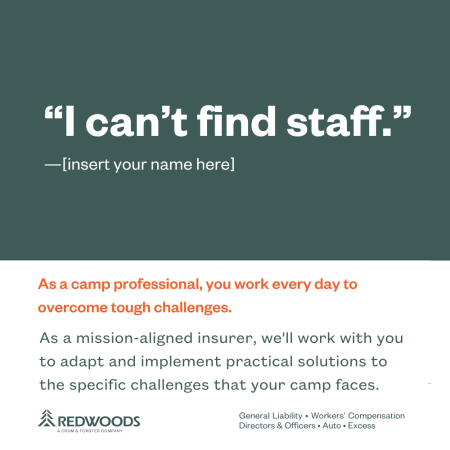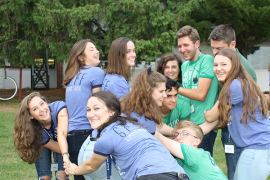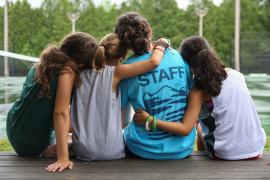Staff recruitment is an ongoing process that too often takes the whack-a-mole approach. With increasing urgency, we try all our traditional recruitment tactics as the countdown clock to camp ticks away. The following is a discussion of how to assess our staff recruitment needs as well as some tips and tricks for connecting with colleges, universities, and other organizations. Our goal is to provide some new ideas and approaches to the process when addressing your camp’s staff recruitment challenges.
For some, the most difficult part of this process is figuring out how and when to start. But why not think of recruitment as an ongoing, 12-month process that simply needs refinement as conditions change? Annual plan development, with reflection on what worked and what needs a different approach, is important. By being intentional about your strategies and ensuring that staff recruitment and retention is a year-round priority, you are more likely to enjoy increased future success.
Assessment and Action Steps
What better time to assess your recruitment efforts than during the summer? You can get real-time, honest feedback about what worked and what didn’t while staff are still at camp. Many camps begin the next season’s registration during the current camp season or soon thereafter — so why not begin to organize your staff recruitment contacts during the summer as well? A few things you can do:
Track where and how you successfully recruited your most recent summer staff (websites, word of mouth, college fairs, and so on). Add this information to your staffing spreadsheet (we hope you have one) so you will remember what was successful for that year.
During a weekly check-in, midsummer evaluation, or just a random conversation after you’ve had time to build a relationship with staff, ask them about their job-search process. What method did they use? Why did they choose to look for a position with that method? What stood out about your camp’s posting or materials?
Set calendar reminders to alert you when it is time to reach out to various contacts. Universities, after-school programs, and schools are getting ready for the next year/semester on a different timeline than you use. And because it’s easy to forget to make these connections during the busy times of the summer, use technology to help you remember.
Think toward the future with your recruitment efforts. If the timing doesn’t work for this year, record the dates for the following year. If you want to offer internships or speak to a group of students in a class or club/organization, it takes time and preparation that may need to happen earlier than you realize.
Is there a way to establish a pipeline with other youth-serving organizations to develop consistent employment opportunities for your staff?
Turnover of full-time employees at your organization can hamper your success in recruiting staff, so leave a record for others to use. Where did you successfully recruit staff? What worked well? What was not fruitful? What are the passwords for sites where jobs are posted? Who are the contacts at the organizations that you connect with for staff? Leaving documents for others to access provides for a seamless transition and is a great training tool for that new employee you may have onboarded to help you with hiring summer staff.
When assessing your recruitment efforts, you may find it necessary to reach out to new types of organizations and contacts during the summer months and into September. You can create a staff recruitment email for this purpose.
Craft Your Message
Consider drafting an email template that will be easy to modify and send to a variety of contacts. Edit based on who you are approaching and how you are asking them to help. Keep the email message short while giving the reader the necessary information about your camp, open positions, and job benefits. Within this introduction of yourself and your organization, consider name dropping or sharing a common connection. And, very importantly, mention your hiring timeline and how this new contact can help.
Do not forget to also bullet out the benefits of working at camp and transferable skills gained from the experience. Refer to ACA’s Project Real Job resources (ACAcamps.org/resources/project-real-job), which help with translating the camp experience. Do you have former staff testimonials to share? If you plan to attach flyers or marketing documents, create reduced-file-size promotional materials, as email listservs often have restrictions on file sizes.
A good option to help you share a wide variety of content is to embed three or four carefully organized links in the email text that will take the reader to such resources as social media posts, videos, and staff applications. The challenge is to keep your email message short, but be sure to include necessary information to make it easy for potential staff to find you and learn more about your employment opportunities.
Where Do I Send This Initial Email?
Create an Excel document and begin to search regionally for a wide range of colleges, universities, and other youth-serving organizations. Do not stop at organizations and educational entities that are large and well known in your region.
Colleges and Universities
Consider a variety of technical schools, junior colleges, community colleges, other small colleges, and universities that offer specialized programs or attract specific majors that might be a good fit for your camp. Search online for comprehensive sites that list a variety of academic institutions that high school juniors and seniors use when exploring post-high school educational opportunities. (Sites like the Princeton Review and College Express allow for a search of colleges by state.)
In addition to marketing to your state colleges and universities, reach out across the region and explore new schools that camps in your area are not approaching. By considering smaller, untapped colleges, you can cast a wider net with the goal of establishing new recruitment contacts and university relationships to work with each year. Camps tend to focus on larger schools in an effort to attract bigger candidate pools; however, small institutions that are not engaged as often may be better able to develop relationships that offer a high impact.
Once on a school’s website, search three areas, focusing on career centers, student activity groups, and faculty within academic departments. Your first contact may be with career center staff. A good practice is to email two or three contacts within an office. Larger universities organize career centers around multiple departments or schools that focus on specific majors. If this is the case, consider reaching out to various career offices within the university system to tap into a variety of majors.
Once you have established contact, ask if their school hosts job fairs, the type of employers that typically attend those fairs, and whether in-person and/or virtual attendance are options. If those fairs are cost prohibitive, inquire about university career and employment websites, and the process to share your information on those sites, the best time to post, and how long your information will remain on the website. Career services offices will often collaborate with camps, helping to schedule on-campus interviews as well as offering opportunities to set up tables in high-traffic, central-campus locations and in classroom buildings. If tabling on campus, think about bringing giveaway items and snacks to attract students to your recruitment area.
A second approach is to look for student activity groups on college websites. This is typically a one-stop location set up for enrolled students to search for on-campus clubs or student activity groups based on their interests. The student activities office link may be in a student section on the campus website that is located under student involvement, activities, or clubs. Once you locate that landing page, the university often provides a searchable listing of all its student activity groups and clubs.
Scroll through the clubs and select a specific organization, which will often provide a faculty advisor’s email or contact information for the organization’s president. These sites may also supply a list of club officers and their email addresses. When communicating with these groups, you might ask if they will share or forward your email to their members through the club email listserv or if they would be willing to present information about your job opportunities at their next meeting. Panhellenic or Greek system organizations can also be located on student activity group pages.
When searching the websites of smaller colleges, reach out to athletic departments for specialty-area staff. Student athletes at smaller institutions may not be required to stay on campus to train during the summer months. You can brainstorm with them to create opportunities to condition and train during camp. If you have workout facilities near or at camp, that can be attractive to potential staff. If you are seeking aquatics staff, work with university campus recreation contacts. Those contacts, especially in smaller colleges that do not have open facilities during the summer months, may be able to suggest trained lifeguards and water safety instructors who hold current certifications.
A third approach is to reach out directly to professors and instructors within identified academic departments. The traditional departments to contact include:
- Parks and recreation
- Education
- Counseling
- Social work
- Theater
- Sports management
- Kinesiology
- Youth development
- Music
- Environmental science/education
Think about other positions and experiences that you could provide to college students who meet summer practicum, internship, and fieldwork requirements. A creative approach is worth it if you need fresh ideas related to such areas as marketing, media/film/videography, human resource management, fundraising, health care, and/or construction management.
When contacting academic department connections, utilize the same email approach, making it short and to the point as it addresses these types of requests:
- Can you visit a class and talk about job opportunities?
- Do they need a guest speaker related to any course content?
- Can you offer to serve on a career panel?
- What timeline works best for them? The end of the fall semester or the beginning of the spring semester?
- Think about partnering opportunities. Who might be able to provide expertise for your camp by assisting with staff training topics, conducting a staff workshop, or speaking at an organizational meeting?
Other Youth-Serving Organizations to Contact
When researching other potential staff-recruiting collaboration partners, look for organizations, service providers, or businesses that have goals and missions similar to your own. Many of these organizations could have committees or interest groups that would enjoy volunteering or working with your camp (coding, woodworking, equity and inclusion training, or rocketry, for example). Some of the identified connections may be more appropriate for day camp, short-term program staffing, or volunteer needs.
Other connections to cultivate:
- Your state’s after-school network
- High school guidance counselors
- Youth-serving organizations (YMCA, Boys and Girls Clubs, youth soccer, scouts)
- After-school providers
- Short-term camps (share staff?)
- Local neighborhood centers
- Respite services
- YWCA
- United Cerebral Palsy
- Social services (food banks, county human services)
- School district staff
- Classroom teachers
- Part-time professionals
- Occupational therapy staff
- Physical therapy staff
- Summer school staff
- Before- and after-school teachers
- Athletics/coaches and physical education teachers
You may be skeptical about connecting with some of these areas or individuals, because many of them also compete to find quality staff to work with students/campers. However, opening a conversation and building relationships can benefit your campers in the long run. And forging these connections means more people will know about your camp, which could lead to an increase in staff and camper referrals, better visibility within your community, and greater credibility as a youth development professional. Ultimately, area services and organizations working together means better community support for your campers and families.
Staff recruitment — whether you call it a plan, process, or task — is an ongoing activity that needs constant attention, documentation, and planning. A thorough assessment of your recruitment needs, along with a year-round action plan, will bring organization and “sense” to this ongoing recruitment process. In addition, your ability to research and build connections and relationships with a variety of higher-education and youth-serving organizations will help you to tap into new talent pools that will enhance your recruitment efforts.
Kelly Coulthard has worked within the afterschool and camp profession for over 25 years. Currently, Kelly provides consultation and training for youth-development organizations through her business Spark 2 Ember Consulting. She also serves as the co-chair for the Wisconsin ACA Local Council of Leaders.
Julie Knapp, PhD, is a clinical assistant professor and internship coordinator at Indiana University-Bloomington, teaching within parks and recreation-focused areas. In her role as internship coordinator, she has worked with a variety of summer camps on facilitating internship and practicum experiences for college students. Julie currently serves as a member of ACA’s Staff Recruitment and Retention Committee.




